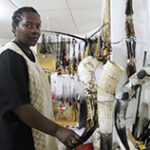Editorial | Spring 2020
Grant Kester
Welcome to FIELD issue #16. This issue has been delayed to mid-summer as a result of disruptions brought about by the COVID pandemic and ongoing protests against racist violence precipitated most recently by the murder of George Floyd, which have transformed daily life for all of us. As heartening as the response to George Floyd’s killing is, one is left to wonder why it took so many deaths to mobilize a sufficient level of public outrage for this crisis to be taken seriously in the mainstream media and political discourse? Why didn’t any of the thousands of previous deaths, from the extra-judicial lynchings of the Jim Crow era to the decades upon decades of harassment and violence visited upon black communities by white police departments around the country? Why not Breonna Taylor, or Atatiana Jefferson or Stephon Clark or Philando Castile or Freddie Gray or Janisha Fonville or Eric Garner, or any of the thousands of other black lives that have been taken by the police? [1] Perhaps we, as a country, have finally reached some kind of tipping point that will lead to an end to this violence, or perhaps the moment will pass with no substantive change, as it so often has in the past. If real change does come, finally, it will be due to the patient, demanding work of activists in the black community who were ignored or openly despised by mainstream culture for decades before this point, from Black Lives Matter to the generations of activists who came before them. This work, the slow, exhausting, creative work of change-making, matters; one action, one consciousness, one small breakthrough at a time. [2] It’s what makes it possible for us to reach a historical moment when something much larger might finally shift in a culture of racist violence that is validated at the highest levels of government in our country. This issue of FIELD includes a set of reflections and images produced by Ricardo Dominguez, who has been involved in protests against racist police violence in New York City. It also features another analysis of the visual culture of protest, focused on street art during Lebanon’s “October Revolution” (2019-20), by Erin Cory, as well as Marc Herbst’s innovative study of the object-nature of social and political transformation in his analysis of Spain’s Platform for People Affected by Mortgages (the PAH, or la Plataforma de Afectados Por La Hipoteca). In addition, FIELD #16 includes reviews of three recent books on socially engaged art, including The Art of Direct Action: Social Sculpture and Beyond, which explores both the historical evolution and contemporary relevance of Joseph Beuys’ activist art practice, Socially Engaged Art in Contemporary China: Voices from Below, which provides the first English-language survey of socially engaged art practices that have emerged in China over the past decade, and Wages Against Artwork: Decommodified Labor and the Claims of Socially Engaged Art, which explores the complex relationship between wage labor and activist art. Finally, this issue includes a review of Austrian artist Oliver Ressler’s video-installation Everything’s coming together while everything’s falling apart, (2016-2020), which documents six examples of climate activism, from France, Germany, the Netherlands, the Czech Republic and Italy. I want to extend special thanks to Noni Brynjolson for her help with this issue during a very challenging time.
[1] https://mappingpoliceviolence.org/
[2] Grant Kester, “Interview with Patrisse Cullors,” FIELD #15 (Winter 2020). http://field-journal.com/stagejanV2/issue-14/interview-with-patrisse-cullors











